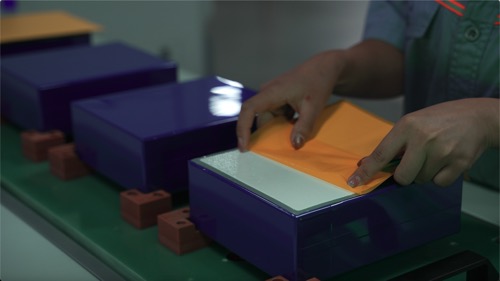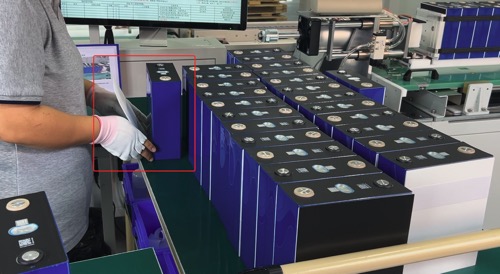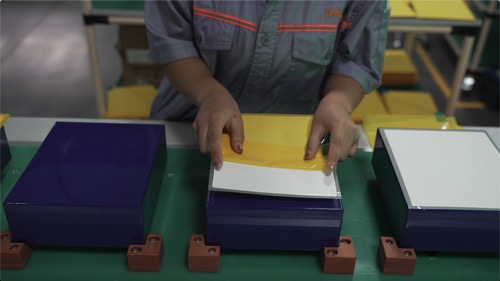In the rapidly advancing energy storage industry, ensuring the safety, efficiency, and longevity of battery modules is critical. One essential yet often overlooked step in the assembly of battery modules is the application of strip glue between battery cells. This seemingly simple measure serves multiple purposes, addressing both structural and operational challenges. Below, we will explore in detail why strip glue is indispensable in the energy storage industry, highlighting its roles in enhancing safety, stability, thermal management, and overall performance.

1. Enhanced Structural Integrity and Stability
One of the primary reasons for using strip glue between battery cells is to provide structural support and stability. Battery cells are typically packed closely together in modules to maximize energy density. Without proper adhesion, these cells are prone to movement or vibration, which can compromise the entire system.
• Vibration Resistance: During transportation, operation, or in applications like electric vehicles or energy storage systems, battery modules are subjected to continuous vibrations. Strip glue securely bonds the cells together, preventing displacement or mechanical wear that could lead to damage over time.
• Mechanical Shock Absorption: External forces, such as drops or impacts, can compromise the internal connections and safety of battery cells. Strip glue acts as a shock-absorbing layer, minimizing the risk of physical damage.
• Structural Cohesion: Strip glue creates a unified structure within the module, which helps maintain the integrity of the battery pack. This is particularly important in energy storage systems deployed in harsh environments or mobile applications like EVs.
2. Improved Thermal Management
Efficient thermal management is a key requirement for the safe operation of battery systems. Battery cells generate heat during charging, discharging, and operation, and managing this heat is crucial to maintaining performance and avoiding safety hazards.
• Thermal Conductivity: Many strip glues are designed with thermally conductive properties, allowing them to dissipate heat effectively. This ensures that individual cells remain at an optimal temperature, avoiding localized overheating and thermal stress.
• Uniform Temperature Distribution: Strip glue facilitates even heat dissipation across the module, preventing the formation of thermal hotspots that could degrade certain cells faster than others. This helps maintain the overall balance and efficiency of the battery pack.
• Thermal Isolation for Safety: In the event of a cell overheating or experiencing thermal runaway, strip glue can act as a thermal barrier, slowing down or even preventing the heat from spreading to adjacent cells. This critical feature helps reduce the risk of cascading failures, which can lead to fires or explosions.

3. Electrical Insulation and Protection
In high-density battery packs, the close proximity of cells can increase the likelihood of electrical short circuits or accidental contact. Strip glue adds a layer of electrical insulation that prevents such issues.
• Prevents Short Circuits: By creating a physical separation between cells, strip glue reduces the risk of contact between conductive surfaces, which could result in short circuits and potential safety hazards.
• Improved Spacing: Strip glue ensures consistent spacing between cells, helping to maintain the intended electrical design of the module. This is particularly important for high-voltage systems where even minor contact issues can lead to catastrophic failures.
4. Enhanced Safety Features
Safety is a paramount concern in the energy storage industry, especially given the risks associated with high-energy-density battery systems. Strip glue contributes significantly to ensuring safety.
• Fire Retardant Properties: Many strip glues are formulated with flame-retardant materials, adding an extra layer of protection in case of overheating or fire hazards. This is critical for ensuring compliance with safety standards and regulations in the industry.
• Minimizing Thermal Runaway Propagation: Thermal runaway is one of the most significant risks in battery systems. Strip glue can act as a containment layer, helping to isolate affected cells and prevent the propagation of heat or flames to adjacent cells.

5. Assembly Efficiency and Consistency
The application of strip glue also simplifies the production and assembly processes of battery modules, contributing to better efficiency and quality control.
• Ease of Cell Alignment: Strip glue helps align battery cells precisely during assembly, ensuring that they are properly positioned and evenly spaced. This is crucial for achieving consistent performance across the module.
• Reduced Reliance on Mechanical Fasteners: By using strip glue, manufacturers can reduce the need for bulky mechanical fasteners, resulting in lighter, more compact battery packs. This is especially important in applications like electric vehicles, where weight reduction is a key design goal.
• Improved Manufacturing Consistency: Strip glue ensures uniform adhesion between cells, reducing variability during production and improving the overall reliability of the final product.
6. Prolonged Battery Lifespan and Reliability
Another significant benefit of applying strip glue is its contribution to extending the lifespan and reliability of the battery module.
• Minimizes Mechanical Stress: Strip glue prevents cells from experiencing physical strain caused by movement, vibration, or impact, which could otherwise lead to internal damage or degraded performance over time.
• Maintains Cell Integrity: By protecting cells from environmental factors like moisture or dust intrusion, strip glue enhances the durability of the battery pack. This is particularly important in outdoor energy storage systems or harsh operating environments.

7. Environmental and Regulatory Compliance
The use of strip glue also aligns with industry regulations and environmental standards.
• Adherence to Safety Standards: The integration of safety-enhancing materials like strip glue helps battery manufacturers meet stringent safety certifications, such as UL 1973 or IEC 62619.
• Sustainability Considerations: Many modern adhesives are designed to be environmentally friendly, reducing the environmental impact of battery production while ensuring compliance with green manufacturing practices.
Conclusion: A Small Step with a Big Impact
In summary, the application of strip glue between battery cells may seem like a minor detail in the grand scheme of energy storage systems, but its impact is profound. From enhancing structural stability and thermal management to improving safety and assembly efficiency, strip glue plays a critical role in ensuring the performance and reliability of battery modules.
As the energy storage industry continues to grow and evolve, innovations in adhesive materials and application techniques will further enhance the safety, efficiency, and sustainability of battery systems. This simple yet effective solution underscores the importance of meticulous attention to detail in designing the next generation of energy storage technologies, paving the way for a greener and safer future.









